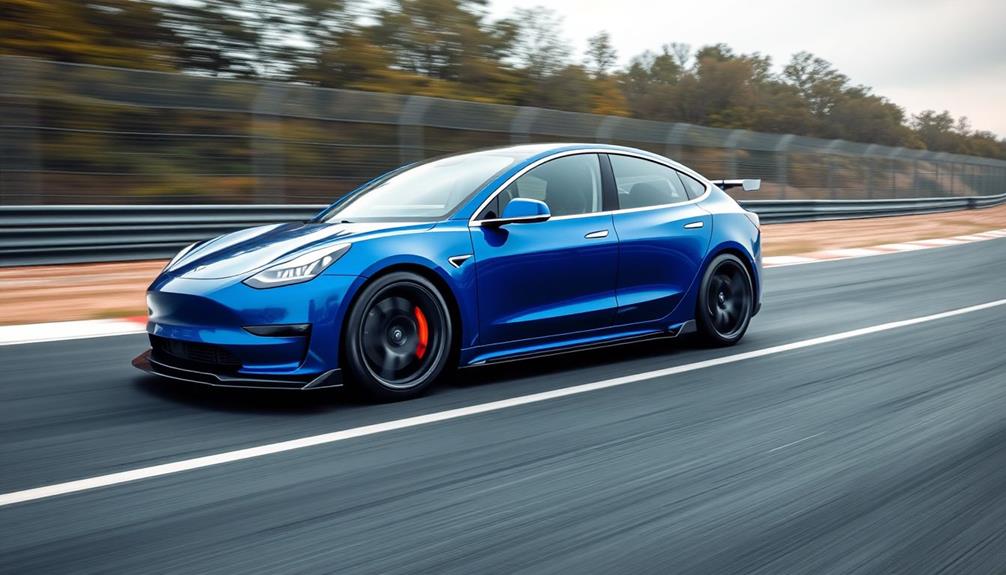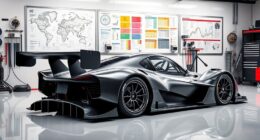Tesla doesn't pay dividends. Instead, it reinvests profits to fuel growth and innovation. Since its inception in 2003, and especially post-IPO in 2010, Tesla's management has kept dividends off the table to focus on expanding production and technology. While the company reported impressive revenues, it's centered on long-term strategies rather than immediate cash returns to shareholders. This approach is typical for high-growth tech firms. If you're considering investing in Tesla, understanding its growth-focused strategy is essential to grasp the bigger picture behind its stock potential. Explore more to uncover what this means for your investment choices!
Key Takeaways
- Tesla has never paid dividends since its founding in 2003 and has no plans to initiate payments soon.
- The company's management prioritizes reinvesting profits for growth, technology development, and increasing production capacity.
- Tesla's focus on innovation and market expansion aligns with a high-growth strategy, attracting growth-oriented investors.
- Analysts do not foresee dividends in the near term, emphasizing the retention of earnings for growth initiatives.
- Tesla's strong revenue growth and market capitalization reflect its commitment to long-term shareholder value through capital appreciation rather than cash returns.
Tesla's Dividend Policy

Understanding Tesla's dividend policy reveals a clear commitment to growth over immediate shareholder returns. Since its inception in 2003, Tesla has never paid dividends on its common stock. Instead, the company prioritizes reinvesting earnings into growth and expansion initiatives.
With a current market capitalization of about $525.17 billion, Tesla's size is impressive compared to traditional automakers. Management has made it clear that there are no plans to initiate dividend payments anytime soon.
This strategy aligns with that of other high-growth tech firms, which often delay dividends until they reach a more mature stage. Analysts suggest that if Tesla were to evaluate dividends, the yield might be low, given the emphasis on reinvesting profits into research and development.
Financial Overview of Tesla
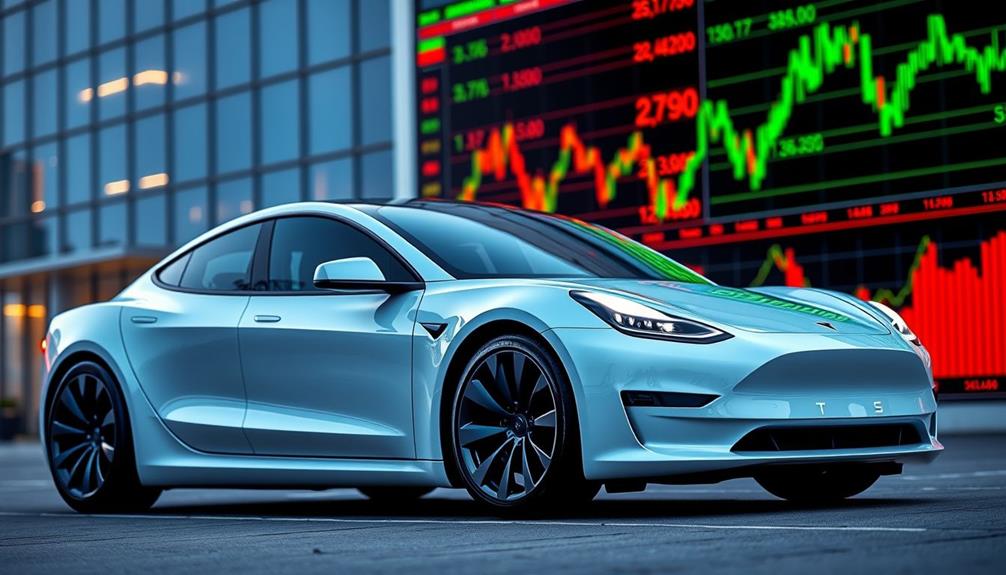
Tesla continues to impress with its financial performance, showcasing robust growth in a competitive market. As of April 2024, Tesla's market capitalization stands at approximately $525.17 billion, making it one of the largest companies globally.
The company has made strategic decisions that align with its long-term vision, choosing not to pay dividends on its shares. Instead, it reinvests earnings to fuel innovation and expansion.
Here are some key financial highlights:
- Q1 FY 2024 revenue reached $119.6 billion, reflecting a 2% year-over-year increase.
- Strong demand for electric vehicles drives this growth.
- Tesla's adjusted earnings per share (EPS) for 2023 was $0.52, slightly missing estimates.
- Overall revenue has consistently beaten expectations.
Reasons for No Dividends

Choosing to forgo dividends, Tesla focuses on reinvesting its profits to drive growth and innovation. Since its IPO in 2010, the company has never declared dividends, preferring to utilize its earnings for expanding production capacity and developing cutting-edge technologies. This strategy requires retaining profits rather than distributing them to shareholders.
Tesla's management has consistently emphasized that not paying dividends is a deliberate choice to prioritize future growth and market expansion. Analysts agree that Tesla's robust growth potential and ongoing investment needs heavily influence this decision.
With a market capitalization exceeding $800 billion, the company is committed to using its cash flow for research, product expansion, and acquisitions instead of returning cash to shareholders.
In the stock market, many investors recognize that Tesla's focus on innovation can drive the stock price higher in the long run. By reinvesting profits, Tesla aims to strengthen its position, making it a compelling choice for those looking to capitalize on growth rather than seeking immediate returns through dividends.
Business Strategy and Growth
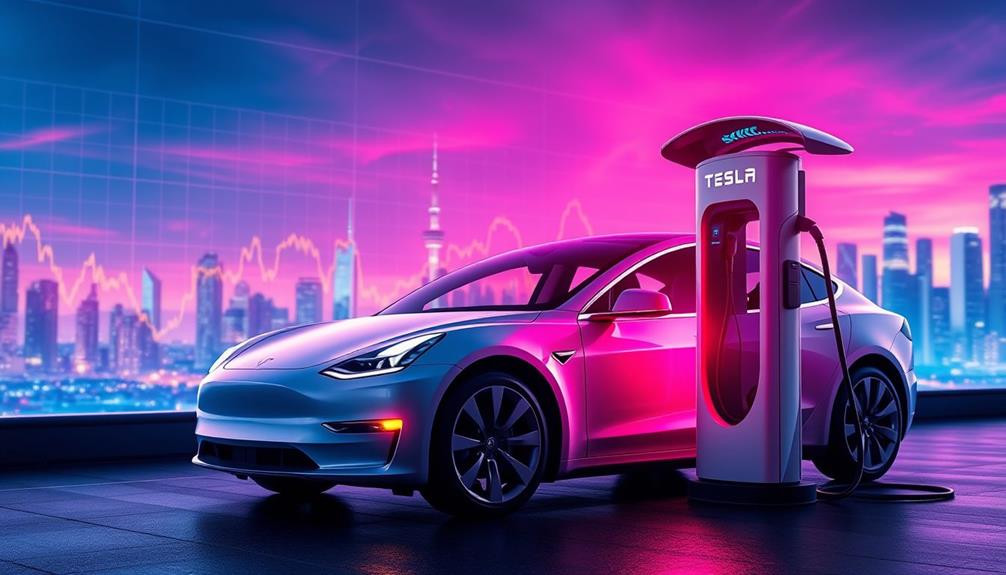
Innovation drives Tesla's business strategy, allowing the company to stay at the forefront of the electric vehicle market. Unlike many companies, Tesla prioritizes reinvestment over dividends, focusing on long-term growth.
Here are four key aspects of Tesla's business model that contribute to its impressive growth rate:
- Expanding Vehicle Production: The success of the Model 3 and Model Y has been pivotal, and new products like a pickup truck and a semi-truck are on the horizon.
- Gigafactories: Tesla has established multiple Gigafactories worldwide, boosting its production capacity to meet the surging demand for electric vehicles.
- Strong Revenue Growth: In 2023, Tesla reported approximately $96.7 billion in revenue, reflecting a robust annual growth rate of 35% from 2018 to 2023.
- Retaining Earnings: The company's long-term strategy includes retaining earnings for research, product expansion, and acquisitions, aligning with its mission to accelerate the world's shift to sustainable energy.
Future Dividend Possibilities
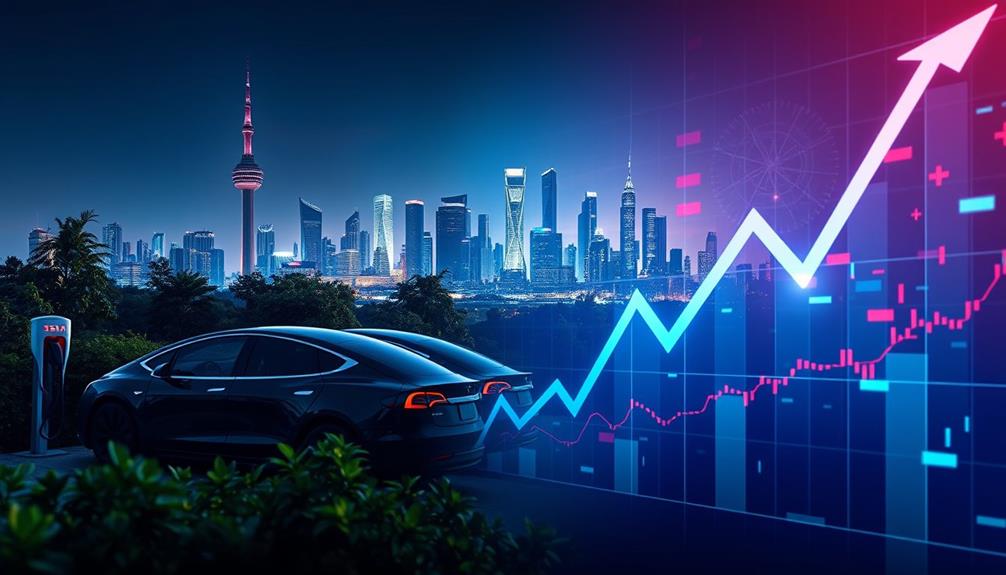
The prospect of future dividends from Tesla remains a topic of interest among investors. However, Tesla has never issued a dividend payment, choosing instead to reinvest its profits into future growth.
Analysts currently don't foresee any cash dividends on the horizon, as Tesla continues to focus on expanding its product line and increasing production capacity.
While Tesla's strong cash flow and profitability indicate the potential for dividends, management emphasizes that retaining earnings is vital for fueling innovation and growth. It's evident that the company prioritizes reinvestment over immediate returns to shareholders.
That said, if Tesla's growth were to stagnate or if new vehicle models fail to captivate consumers, the conversation around dividends might change. Market dynamics and competitive pressures could also sway Tesla's decision-making regarding dividend distributions in the future.
For now, if you're holding Tesla stock, it's important to recognize that any cash dividends are unlikely in the near term. Instead, the company's focus remains firmly on growth initiatives that promise long-term value for shareholders.
Tesla's Market Position

Although Tesla has never declared dividends, its remarkable market position underscores the company's strategy of prioritizing growth over immediate shareholder returns. With a market capitalization exceeding $800 billion, Tesla stands out notably compared to traditional automakers like Ford and GM, combined. This powerful position allows you to see the potential in the electric vehicle market.
Here are some key factors contributing to Tesla's market position:
- Revenue Growth: In 2023, Tesla generated approximately $96.7 billion in revenue.
- Profitability: The company reported a net income of $15 billion, reflecting improved profitability since 2020.
- Global Reach: Tesla delivered over 1.8 million vehicles in 2023, showcasing its strong presence in the EV market.
- Stock Potential: Analysts predict a 22.27% increase in TSLA stock, with a target price of $201.63 for the upcoming year.
These elements not only illustrate Tesla's market position but also highlight its commitment to future growth.
As investors, understanding these dynamics can help you navigate the landscape of Tesla's stock and its long-term potential.
Investing in Tesla Stock

When you consider investing in Tesla stock, you're looking at a growth-oriented strategy that prioritizes reinvestment over dividends.
However, it's crucial to weigh the potential risks and market volatility against the company's impressive financial performance.
As you explore this opportunity, think about how Tesla's focus on innovation and expansion aligns with your investment goals. By continuously pushing the boundaries in electric vehicles, energy solutions, and autonomous driving technologies, Tesla demonstrates a commitment to long-term growth. Additionally, their expansion into global markets presents a unique opportunity for investors seeking substantial returns. For those interested in understanding company metrics, **Tesla unit measurement explained** can offer insight into how production, deliveries, and profitability are quantified across different segments.
Growth-Oriented Investment Strategy
Investing in Tesla stock represents a compelling growth-oriented strategy for those looking to tap into the booming electric vehicle market.
Tesla has never paid dividends, opting instead to reinvest earnings to finance future growth and innovation. This approach aligns with its high-growth focus and strategic goals, making it an attractive option for investors who prioritize potential over immediate income.
Here are four reasons why you might consider investing in Tesla shares:
- Strong Revenue Growth: Tesla generated approximately $96.7 billion in revenue in 2023, showcasing robust demand for electric vehicles.
- High Market Capitalization: With a market cap exceeding $800 billion, Tesla's stock is a significant player in the market.
- Future Potential: Analysts expect Tesla to continue its capital-intensive expansion, suggesting that dividends aren't likely in the near future.
- Volatile Stock Price: The stock has seen considerable price movements, offering opportunities for growth-oriented investors.
Risks and Considerations
Understanding the risks and considerations of investing in Tesla stock is essential for making informed decisions. Tesla's Board of Directors has consistently chosen to reinvest earnings rather than pay cash dividends to shareholders. This strategy prioritizes future growth over immediate payouts, making it vital for you to evaluate your investment goals.
With a market capitalization exceeding $800 billion, Tesla's focus on expansion mirrors that of other high-growth tech firms. While analysts note that Tesla has positive free cash flow, they predict that the company is unlikely to initiate paying a dividend anytime soon. This is largely due to the ongoing high-growth strategy and substantial reinvestment needs.
If you're seeking income stability, it's important to recognize that Tesla's stock may not fit well into your income-focused portfolio. The absence of cash dividends means you won't benefit from regular income, which could affect your overall investment strategy.
Future considerations regarding dividends will largely hinge on Tesla's ability to maintain high growth rates and navigate competitive pressures in the electric vehicle market. Investing in Tesla requires a clear understanding of these risks and a readiness to focus on potential long-term gains.
Comparison With Dividend Stocks
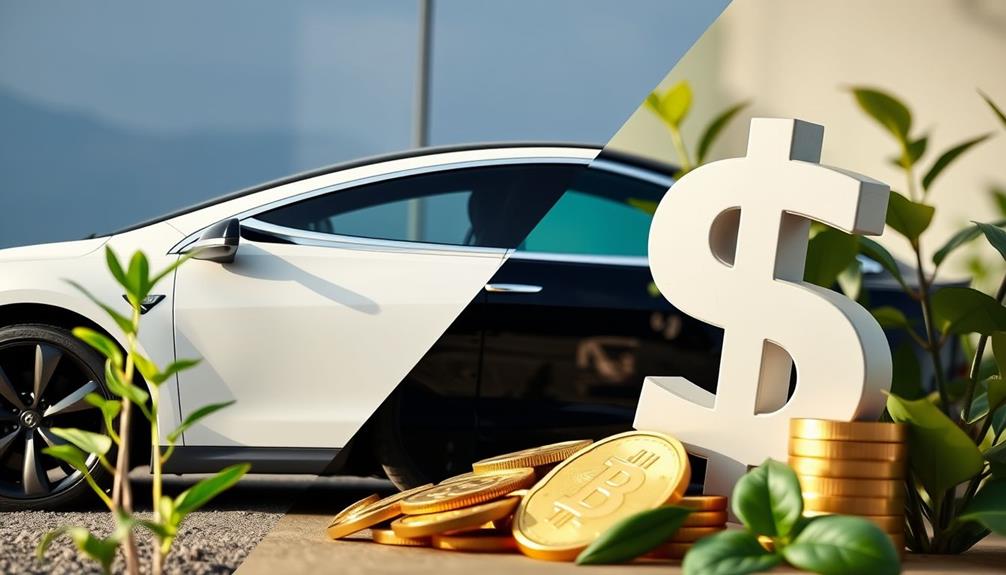
When you look at Tesla's approach to dividends, you'll see a clear contrast with traditional dividend-paying stocks.
While companies like AT&T and Microsoft offer regular payouts, Tesla focuses on reinvesting its earnings for growth.
This raises an important question: should you prioritize capital appreciation like Tesla, or seek the steady income provided by dividend stocks?
Tesla's Dividend Policy Overview
Focusing on growth rather than dividends, Tesla has carved out a unique position in the market. Tesla's dividend policy has always leaned towards retaining earnings instead of issuing cash or stock dividends. This strategy allows the company to reinvest profits into future growth, particularly in research and development.
Here are a few key points about Tesla's approach:
- No Cash Dividends: Tesla has never issued cash dividends to shareholders.
- Reinvestment Focus: The company prioritizes reinvesting earnings for innovation and expansion.
- Market Position: With a market cap of approximately $525.17 billion, Tesla remains a significant player without dividend payouts.
- Analyst Predictions: Analysts suggest that Tesla is unlikely to initiate dividends soon, as high growth rates are prioritized.
In contrast to established dividend payers like Microsoft and Apple, Tesla appeals to growth-focused investors.
With projections estimating a price target of $201.63, Tesla aims to attract those interested in potential stock appreciation rather than immediate income through dividends.
This forward-thinking approach highlights Tesla's commitment to maintaining its competitive edge in the ever-evolving automotive and energy sectors.
Dividend Payers Comparison
Tesla's approach to dividends sharply contrasts with traditional dividend-paying companies, creating a distinct investment landscape. Unlike established dividend payers like AT&T and IBM, which provide regular dividends of 5.43% and 3.31% respectively, Tesla has never distributed dividends to its shareholders.
Instead, the company focuses on reinvesting its earnings to fuel growth and innovation. This strategy positions Tesla differently from firms like Microsoft and Apple, which began paying dividends after achieving substantial growth.
Analysts predict Tesla is unlikely to initiate dividend payments anytime soon, emphasizing the company's commitment to retaining earnings for expansion rather than distributing cash to investors.
This focus attracts a different type of investor—those who prioritize growth over income. While companies such as Chevron and EOG Resources appeal to income-focused investors with consistent dividend payments, Tesla draws in investors seeking long-term capital appreciation.
Growth Vs. Income Investing
Investors face an essential decision between growth and income strategies, each appealing to different financial goals and risk tolerances.
If you're considering Tesla's stock, it's vital to understand how it contrasts with traditional dividend stocks. Tesla prioritizes future growth and innovation over paying dividends in the foreseeable future, while companies like Apple and Microsoft provide regular income through dividend growth.
Understanding common financial terms can also help in making informed decisions about these investment types.
Here are four key differences between growth and income investing:
- Income Stability: Dividend stocks like AT&T and Chevron offer yields of 5.43% and 4.42%, providing steady income.
- Capital Appreciation: Tesla's stock primarily focuses on potential capital appreciation, with analysts predicting a 22.27% increase due to high demand for electric vehicles.
- Investment Strategy: Growth investors often prefer reinvestment in companies that fuel future growth, while income investors seek immediate returns.
- Risk Tolerance: Growth stocks, like Tesla, can be more volatile, which may not suit every investor's risk profile.
Tesla's commitment to integrated sustainable energy makes it appealing for those willing to forgo dividends for promising future gains.
Choose your strategy wisely!
Long-Term Value Considerations

When weighing long-term value considerations for Tesla, it's clear that the company has chosen to hold back on dividends to fuel its ambitious growth trajectory. By not paying dividends, Tesla prioritizes reinvesting its profits into future growth, which greatly enhances its long-term value. This strategy has allowed Tesla's stock to soar, achieving a market capitalization exceeding $800 billion, far outpacing traditional automakers like Ford and GM.
In 2023, Tesla generated about $96.7 billion in revenue, showcasing strong financial performance even amid missed earnings per share estimates. The decision to retain earnings indicates that investors should look for returns through stock price appreciation rather than regular dividend payments. Tesla ownership details
In addition to a strong financial performance, Tesla’s decision to retain earnings suggests that the company is focused on reinvesting in its own growth and innovation. This may be particularly appealing to investors who are looking for long-term potential and believe in Tesla’s future prospects. Tesla ownership details, such as stock purchase and dividend policies, will be important considerations for investors looking to capitalize on the company’s growth and success.
Analysts predict that Tesla's stock could increase by 22.27% over the coming year, underscoring the potential for noteworthy long-term value.
For you as an investor, it's crucial to understand that while Tesla won't pay dividends, the company's reinvestment strategy could yield greater rewards down the line. By focusing on growth and innovation, Tesla positions itself to capitalize on emerging opportunities, making it a compelling choice for those willing to embrace a long-term investment outlook.
Frequently Asked Questions
Why Has Tesla Never Paid Dividends?
Tesla's never paid dividends because it prioritizes reinvesting profits into growth and innovation. By doing this, it focuses on expanding its market presence and enhancing product offerings, ensuring long-term sustainability and value for shareholders.
How Much Is Tesla's Dividend per Share?
Imagine a landscape where growth blossoms instead of dividends. You won't find a dividend per share for Tesla—it's zero. The company pours its profits into innovation, choosing expansion over payouts, keeping its future bright.
Are Tesla Shares Worth Buying?
If you're considering Tesla shares, think about their growth potential. With strong revenue and an optimistic outlook, investing now could yield substantial returns, but remember, they're not for those seeking immediate income through dividends.
What Is the Average Dividend Yield for a Tesla?
You won't find an average dividend yield for Tesla, as the company hasn't paid dividends since 2003. It prefers reinvesting profits into growth opportunities instead of distributing cash to shareholders.
Conclusion
In summary, Tesla's not handing out dividends anytime soon, and that's a wild ride you might just want to buckle up for! With their focus on explosive growth and innovation, they're putting every cent back into the rocket fuel of their business. So, instead of chasing dividends like a mirage in the desert, consider the thrilling journey of Tesla's stock. You might just find the real treasure is in the long-term potential, and that's a jackpot worth chasing!



